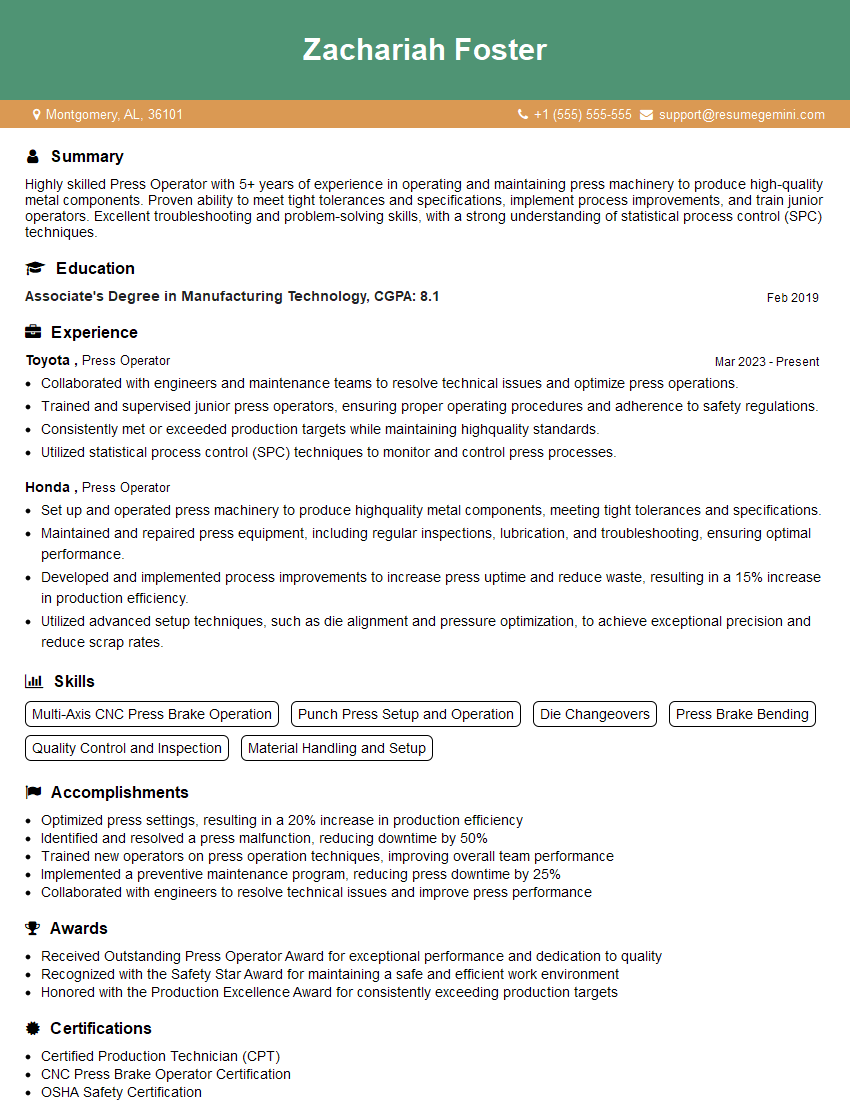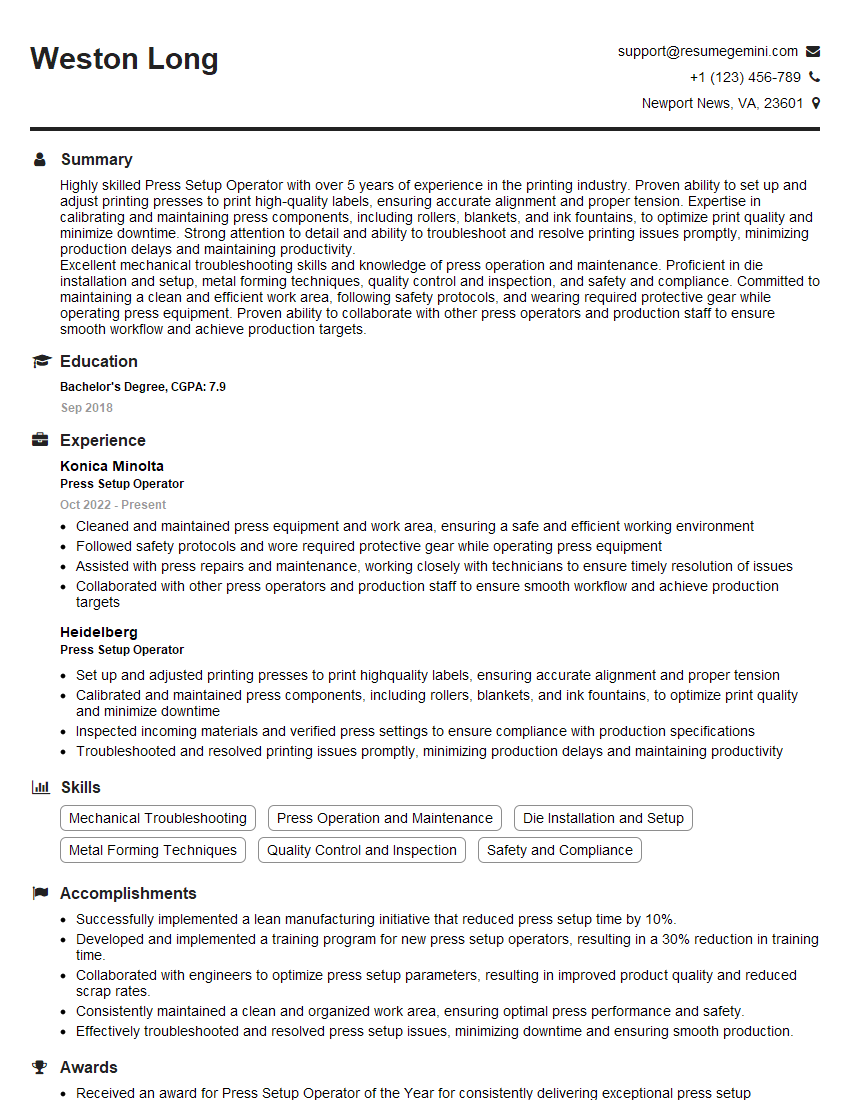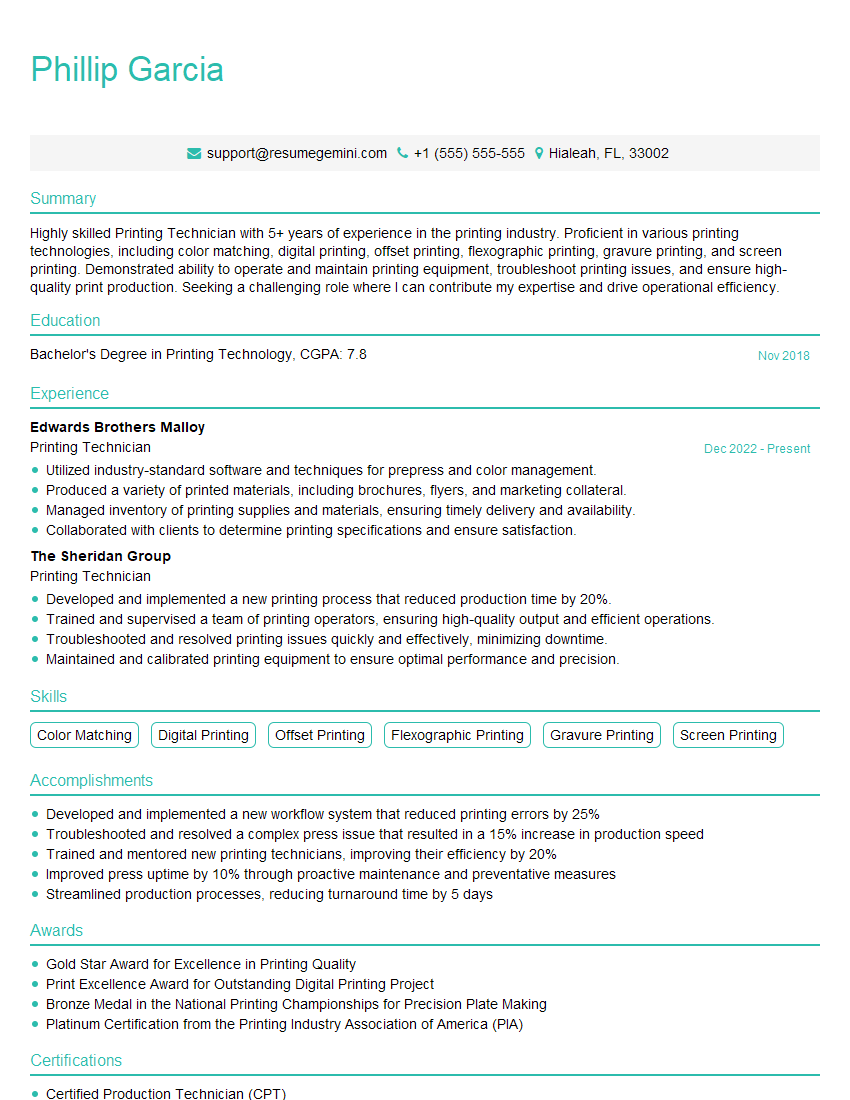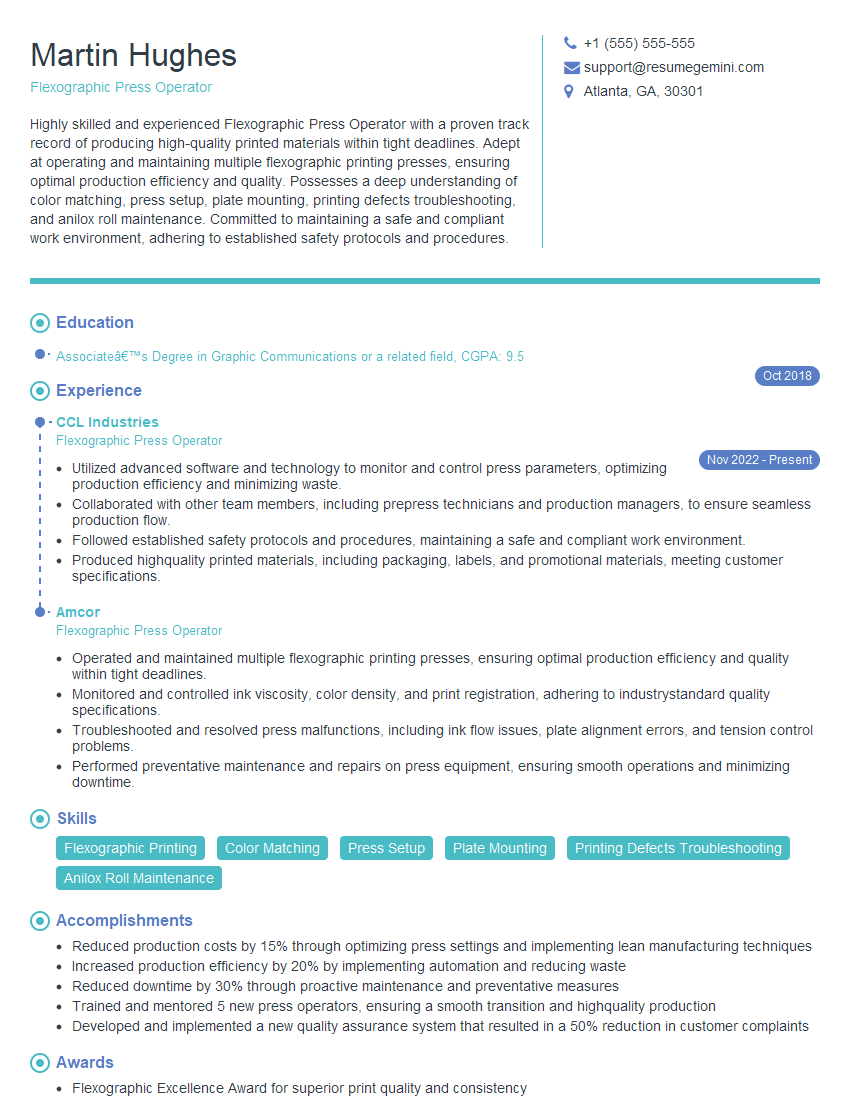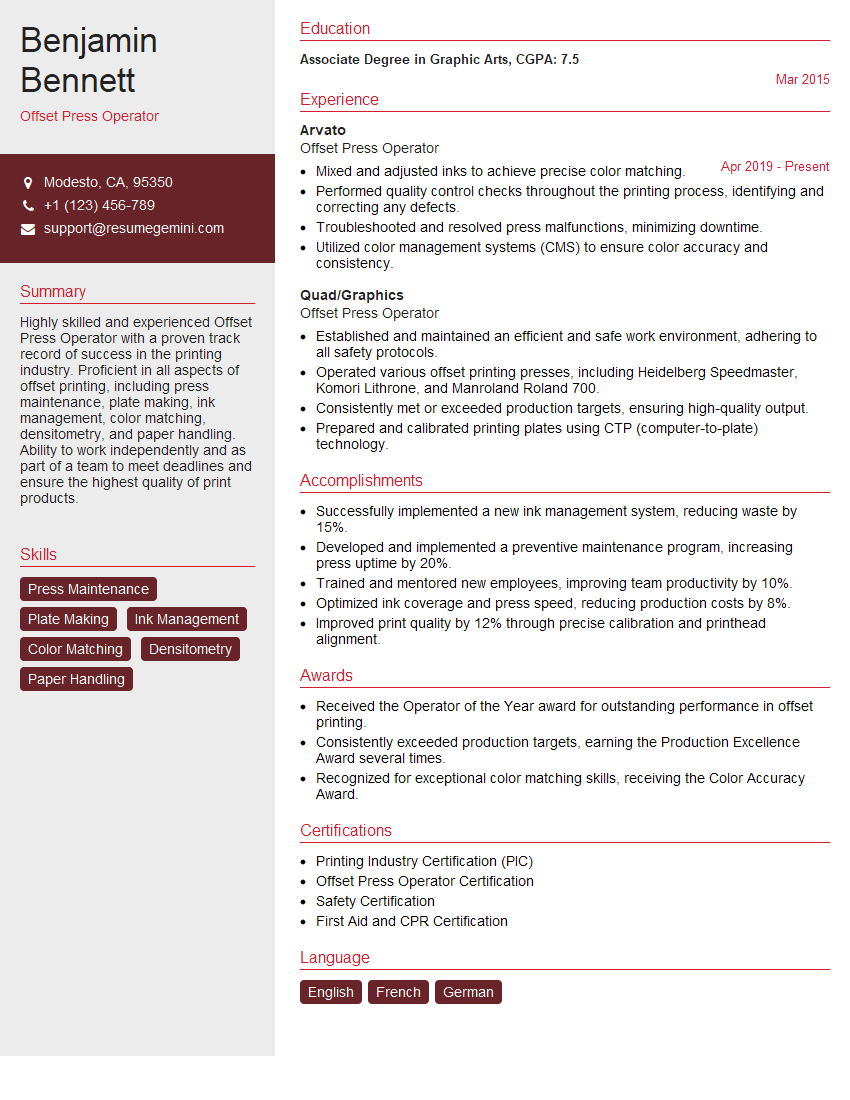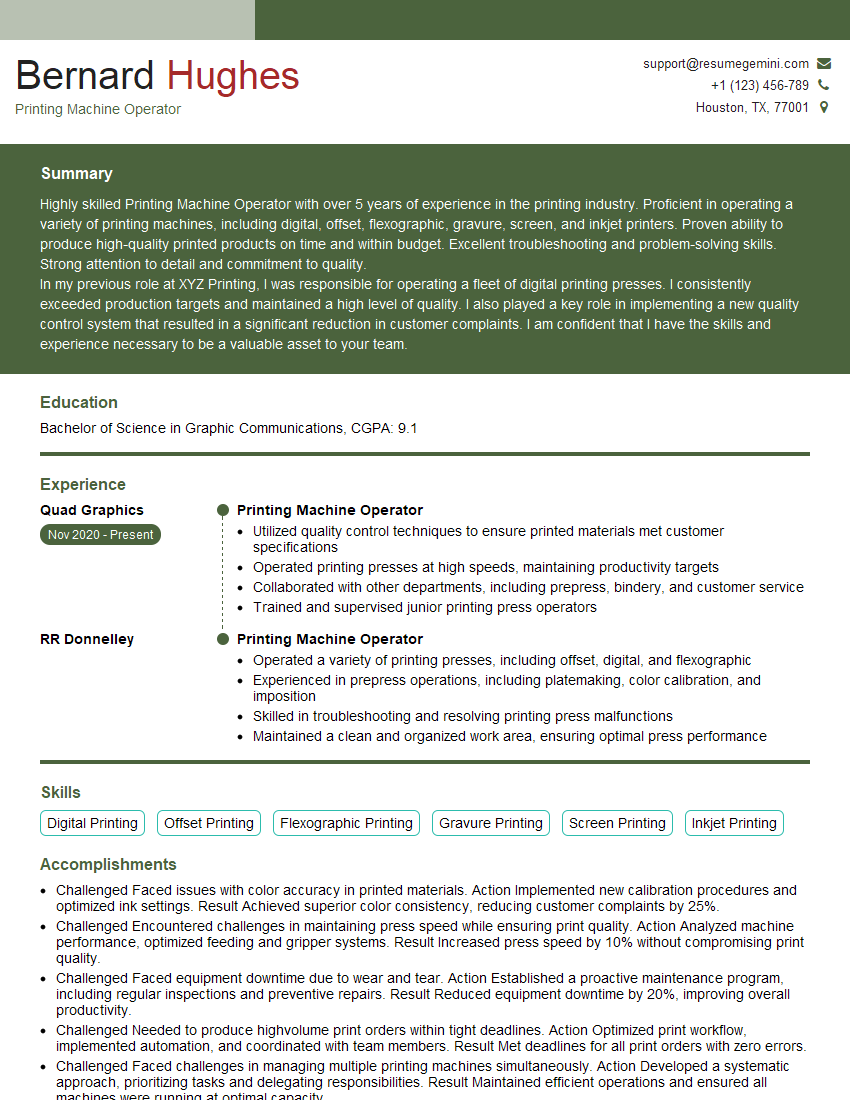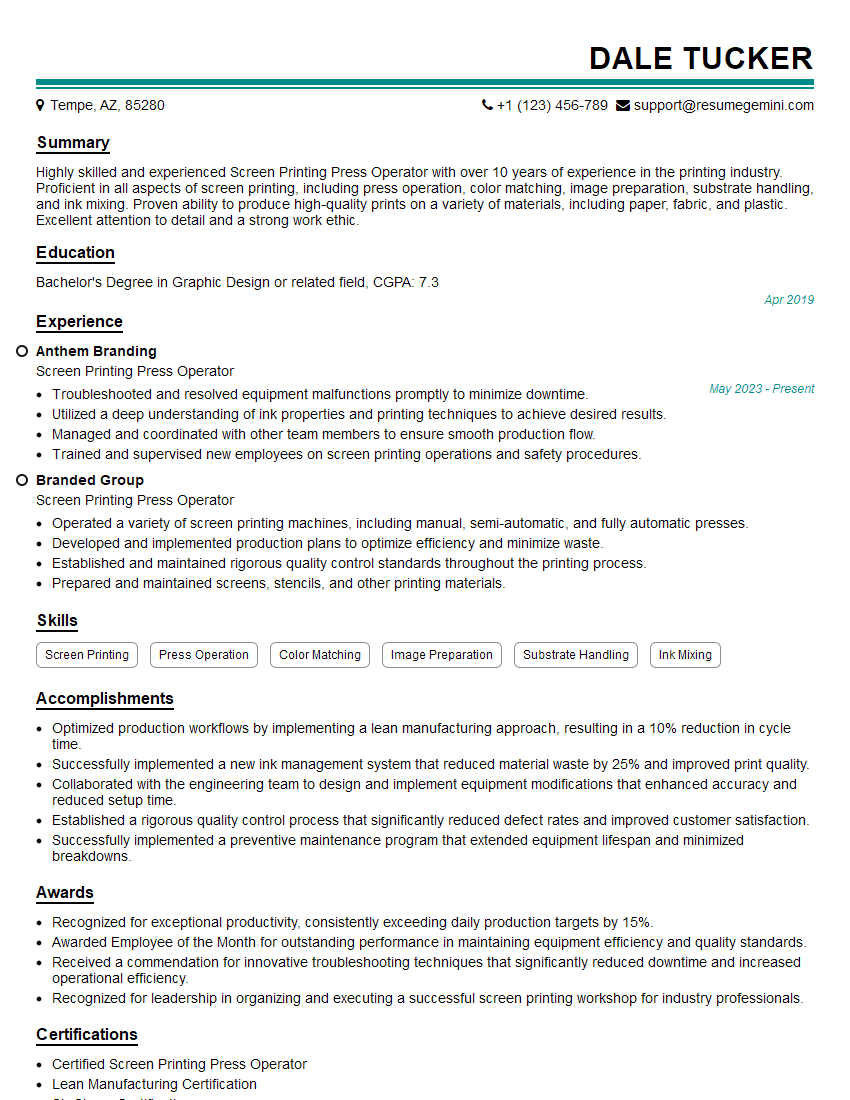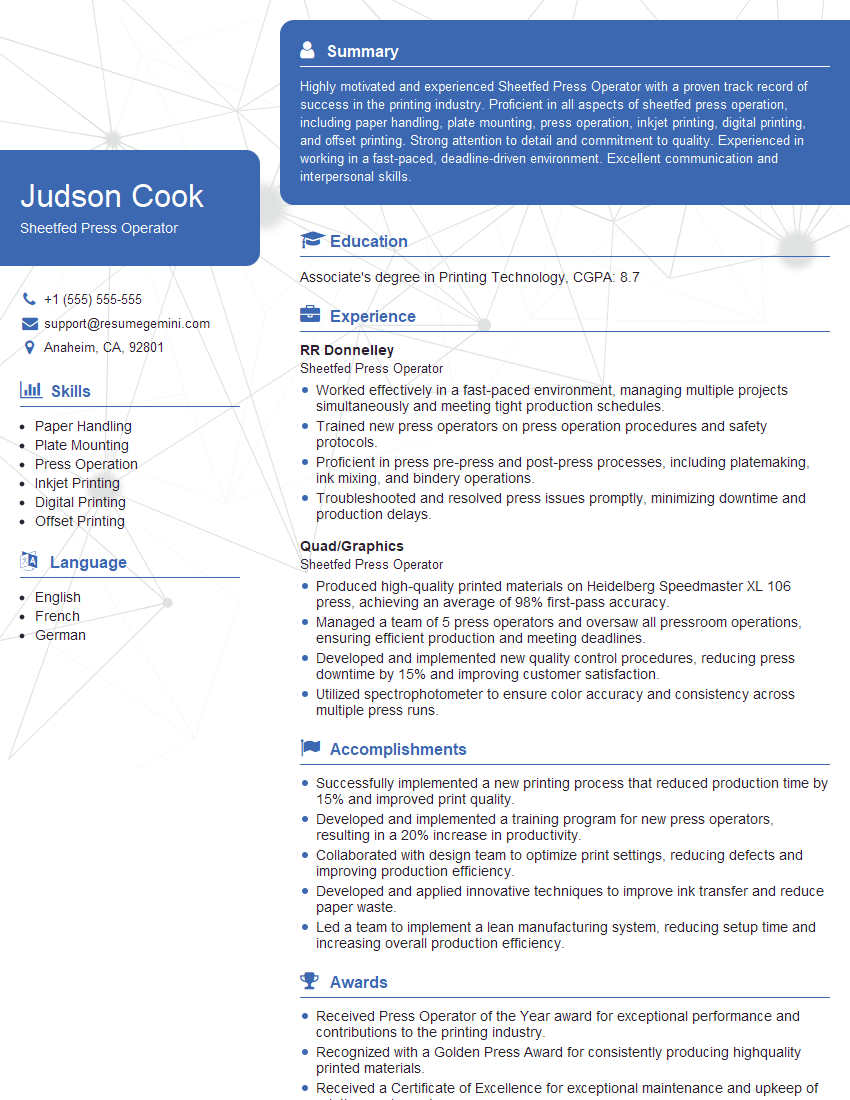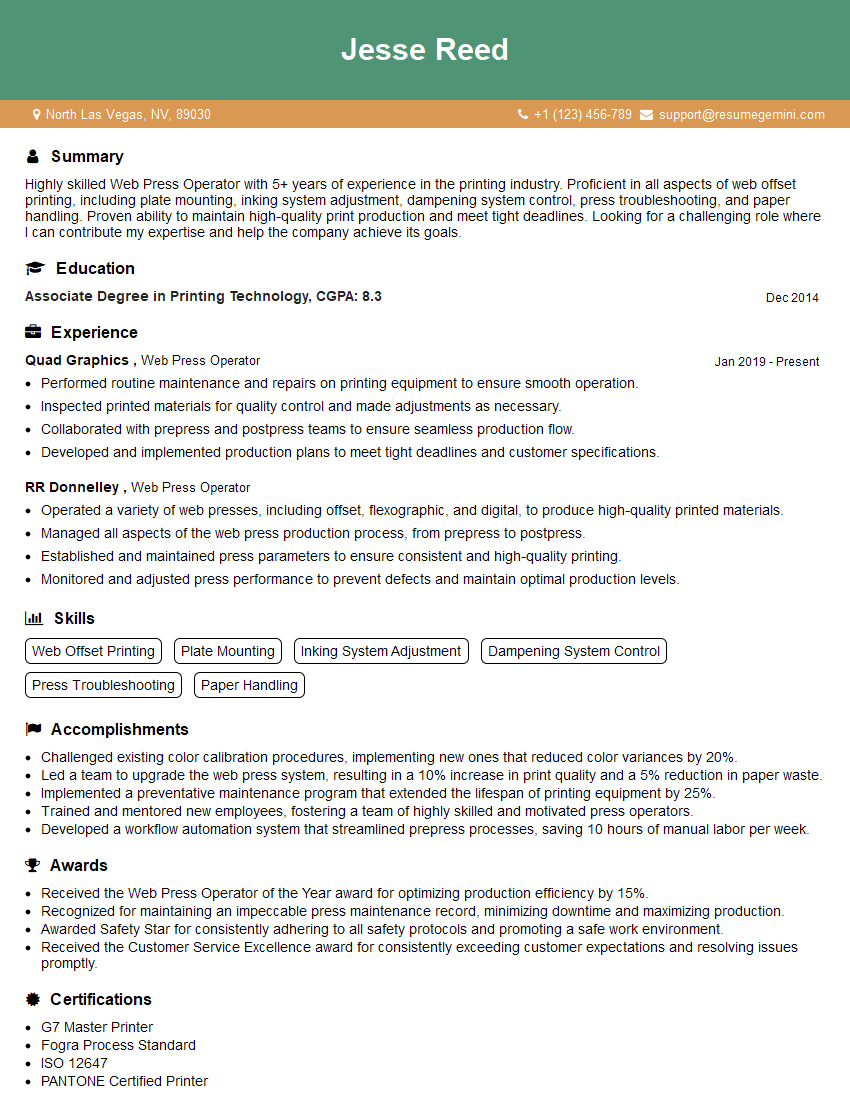The right preparation can turn an interview into an opportunity to showcase your expertise. This guide to Press Operator interview questions is your ultimate resource, providing key insights and tips to help you ace your responses and stand out as a top candidate.
Questions Asked in Press Operator Interview
Q 1. Describe your experience with different types of printing presses.
Throughout my career, I’ve gained extensive experience operating various printing presses, including sheetfed offset presses (both small and large format), web offset presses, and digital printing presses. My experience with sheetfed offset presses spans different manufacturers like Heidelberg and Komori, each having its unique nuances in operation and maintenance. I’m proficient with both perfecting and perfecting-with-coating presses, understanding the intricacies of multi-color printing and the challenges associated with aligning and registering colors across multiple units. Working with web offset presses involved managing higher production volumes and the complexities of web handling and roll changes. Finally, my experience with digital presses gave me a strong grasp of variable data printing and faster turnaround times, often used for personalized marketing materials. Each press type demands a different skill set and approach, and I’ve adapted effectively to each one.
Q 2. Explain the process of setting up a printing press for a new job.
Setting up a printing press for a new job is a meticulous process requiring precision and attention to detail. It begins with a thorough review of the job specifications, including the substrate (paper type and weight), ink colors, desired image quality, and quantity. I first verify the press is clean and properly maintained. Next, I would install the correct printing plates, meticulously checking their registration and ensuring they are securely mounted. The next step involves calibrating the ink keys and setting the dampening system to achieve the desired ink-water balance, which is crucial for achieving consistent color and preventing issues like dot gain or mottling. Then, I perform a test print, closely examining color accuracy, registration, and image sharpness. Adjustments are made iteratively until the desired quality is achieved before proceeding with the full print run. For instance, if a color is too dark, I might reduce the ink supply to that unit, or if there is poor registration, I’ll fine-tune the plate cylinders. This iterative process ensures a smooth, high-quality print job from start to finish.
Q 3. How do you ensure consistent color accuracy in your printing?
Maintaining consistent color accuracy is paramount in printing. My approach is multifaceted. Firstly, I utilize color management systems and color profiles specific to the press, inks, and substrate. I perform regular color calibrations using color charts and spectrophotometers, ensuring accurate color reproduction. Secondly, I meticulously monitor ink density throughout the run, making adjustments as needed to maintain consistency. Environmental factors like temperature and humidity can impact color, so I take note of these conditions and adjust accordingly. Furthermore, I closely examine the ink keys and dampening rollers to ensure they are free from contamination and that the ink-water balance is properly maintained. I’ve found that regular cleaning and maintenance of the press prevent color inconsistencies caused by build-up on rollers and other parts. For instance, a sudden shift in color might signal a need for roller cleaning or a re-calibration of the ink system. By paying close attention to these details and taking proactive measures, I consistently produce prints that meet, and often exceed, client expectations in terms of color accuracy.
Q 4. What are the common causes of printing defects and how do you troubleshoot them?
Common printing defects can stem from various sources. For example, ink streaking can be caused by incorrect ink-water balance, clogged rollers, or insufficient ink viscosity. Poor registration might be due to improper plate mounting or wear on the press components. Mottle, an uneven distribution of ink, can result from inadequate ink-water balance or problems with the fountain solution. Hickies, small specks of debris in the print, often originate from dirty rollers or plates. My troubleshooting approach involves a systematic investigation. I begin by examining the print for the location and pattern of the defect, which helps pinpoint the likely cause. For instance, streaking along one side of the sheet points towards a problem in the inking system on that side. I then check the plates, rollers, blankets, and dampening system, cleaning or adjusting as needed. If the problem persists, I consult the press’s manual or contact a qualified technician for assistance. I’ve learned over time that meticulous preventative maintenance goes a long way in minimizing these defects and ensuring a smooth workflow.
Q 5. Describe your experience with pre-press and post-press processes.
My experience extends beyond just operating the press; I have a good understanding of pre-press and post-press processes. In pre-press, I’m familiar with evaluating artwork for printability, ensuring proper color separation and file preparation, and reviewing the proof to ensure it aligns with the client’s expectations. I also worked with digital proofing systems and file preparation software. Post-press includes various finishing techniques like cutting, folding, binding, and lamination. I’ve collaborated with post-press operators to ensure the final product’s quality and timely delivery. For instance, in one project, I worked closely with the pre-press team to address some issues related to color consistency in the provided artwork; this ensured that the final product was vibrant and true to the client’s expectations. Understanding both ends of the workflow allows me to anticipate potential problems and contribute to a smoother overall printing process.
Q 6. How do you maintain and clean a printing press to ensure optimal performance?
Regular maintenance and cleaning are vital for optimal press performance and longevity. My routine includes daily cleaning of rollers, blankets, and other press components to remove ink residue and debris. I also conduct weekly more thorough cleaning, paying special attention to the fountain solution system. Lubrication of moving parts is crucial to prevent wear and tear. I follow the manufacturer’s recommended maintenance schedule, performing preventative checks and adjustments as necessary. I keep meticulous records of all maintenance activities, documenting any issues and corrective actions. This proactive approach significantly reduces downtime, improves print quality, and extends the lifespan of the equipment. Regular maintenance is not merely about cleaning; it’s a crucial element in ensuring high-quality printing and preventing costly repairs down the line. It’s like regularly servicing your car to ensure efficient and trouble-free driving.
Q 7. What safety precautions do you follow while operating a printing press?
Safety is paramount when operating a printing press. Before starting any task, I always ensure that the press is properly powered down and locked out. I utilize appropriate personal protective equipment (PPE), including safety glasses, hearing protection, and gloves. I understand the potential hazards related to moving parts and high-voltage electricity and remain vigilant during operation. I follow all lockout/tagout procedures religiously and never bypass safety mechanisms. Regular inspections of the press are conducted to identify any potential hazards. Proper training and adherence to company safety regulations are essential aspects of my work ethic. Safety is not just a set of rules; it’s a mindset and a personal commitment to protecting myself and my colleagues.
Q 8. How do you manage ink and paper inventory efficiently?
Efficient ink and paper inventory management is crucial for smooth printing operations and cost control. It involves a combination of careful planning, accurate tracking, and proactive ordering.
- Regular Stock Audits: I conduct regular physical inventory checks to compare actual stock levels with recorded data. This helps identify discrepancies and potential shortages before they impact production.
- Minimum Stock Levels: I maintain pre-determined minimum stock levels for both ink and paper, factoring in lead times for reordering and typical usage rates. This ensures we never run out of essential materials.
- Just-in-Time Ordering: For frequently used items, I utilize a just-in-time (JIT) ordering system, minimizing storage costs while ensuring timely replenishment. This requires accurate demand forecasting.
- Vendor Relationships: Strong relationships with reliable vendors are essential. Negotiating favorable pricing and delivery terms can significantly reduce costs and ensure a consistent supply.
- Waste Reduction: Minimizing waste through careful press setup and efficient operation is vital. This not only saves materials but also reduces environmental impact.
For example, during a recent large-scale printing project, by meticulously tracking ink usage and implementing a JIT system for the most common colors, we reduced ink waste by 15% and avoided costly delays.
Q 9. Explain your understanding of color management systems (e.g., Pantone, CMYK).
Color management systems are critical for ensuring consistent and accurate color reproduction across different printing processes. Pantone and CMYK are two widely used systems.
- Pantone Matching System (PMS): This uses a standardized color library with specific formulas for each color. It’s ideal for ensuring precise color matching, especially for brand-critical applications where consistency is paramount (e.g., logos, corporate branding). Each Pantone color has a unique number, ensuring everyone involved knows exactly which color is required.
- CMYK (Cyan, Magenta, Yellow, Key/Black): This subtractive color model is used in most four-color printing processes. It mixes these four inks to create a wide range of colors. While less precise than Pantone, it’s more cost-effective for large-scale printing. Accurate color profiles and calibration are crucial to achieving consistent results in CMYK.
I’m proficient in both systems and understand how to convert between them. For instance, I often use Pantone color specifications for client-approved logos and then convert them to CMYK equivalents for the printing press, using specialized software to minimize color discrepancies.
Q 10. How do you handle unexpected equipment malfunctions?
Handling unexpected equipment malfunctions requires a calm, systematic approach. My response always prioritizes safety and minimizes downtime.
- Safety First: I immediately shut down the press and secure the area to prevent injury. This is the most important step.
- Identify the Problem: I systematically diagnose the issue, checking obvious things like power supply, ink flow, and paper feed. I often refer to the machine’s troubleshooting manual.
- Attempt Minor Repairs: If the problem is minor (e.g., a paper jam), I’ll attempt to fix it myself, based on my training and experience.
- Contact Maintenance: If I can’t resolve the issue or if it’s serious, I immediately report it to the maintenance team, providing clear and concise information about the problem. I’ll also note the time of the malfunction and any relevant details.
- Preventative Maintenance: I believe in regular preventative maintenance to minimize unexpected breakdowns. I always ensure that daily and weekly checks are done.
For instance, I once encountered a sudden paper jam during a high-priority job. After safely shutting down the press, I quickly identified the cause as a misaligned paper feeder. I successfully resolved the jam within minutes, minimizing production delays.
Q 11. Describe your experience with different types of printing inks.
My experience encompasses a variety of printing inks, each with unique properties and applications.
- Water-based inks: Environmentally friendly, suitable for various paper types, but often less vibrant than solvent-based inks. Used commonly for packaging and book printing.
- Solvent-based inks: Produce vibrant colors and are durable, but have a stronger odor and require careful handling due to VOCs (Volatile Organic Compounds). Often used for high-quality commercial printing.
- UV (Ultraviolet) curing inks: Cure instantly upon exposure to UV light, resulting in a quick drying time and scratch-resistant finish. Ideal for packaging, promotional materials, and applications requiring immediate handling.
- Specialty inks: Metallic inks, fluorescent inks, and other specialty inks offer unique visual effects, expanding creative possibilities. These require specific press settings and careful handling.
Understanding the characteristics of each ink type is essential for optimal print quality and efficient press operation. For example, when working with UV inks, I adjust the curing lamps’ intensity to ensure proper curing and prevent smudging.
Q 12. How familiar are you with different paper types and their properties?
Different paper types have varying properties that significantly impact print quality and the overall outcome. Understanding these properties is crucial for choosing the right paper for a specific project.
- Coated paper: Provides a smooth surface for crisp, high-quality images and sharp text. Commonly used for magazines, brochures, and high-end print jobs.
- Uncoated paper: Has a more porous surface, giving a softer feel and allowing for better ink absorption. Suitable for invitations, business cards, and stationery.
- Recycled paper: Environmentally friendly option that may have slightly lower brightness and smoothness. Excellent for eco-conscious projects.
- Specialty papers: Textured papers, colored papers, and other specialty papers offer unique visual and tactile qualities. The selection depends on the project’s creative requirements.
For instance, when printing high-resolution images, I’d choose a coated paper to ensure sharp details and vibrant colors. Conversely, for a rustic-style invitation, I’d opt for a textured uncoated paper to enhance its aesthetic appeal.
Q 13. How do you monitor and adjust the press speed and pressure for optimal results?
Monitoring and adjusting press speed and pressure are crucial for achieving optimal print quality and efficiency. This involves careful observation, precise adjustments, and a good understanding of the press’s capabilities.
- Initial Setup: I start with the manufacturer’s recommended settings as a baseline and then make adjustments based on the specific job requirements and the type of paper and ink being used.
- Monitoring: During the print run, I continuously monitor the printed output, checking for consistent color, sharpness, and registration (alignment of colors). I also keep an eye on the paper feed and ink flow.
- Adjustments: If inconsistencies appear, I carefully adjust the press speed and pressure, making small incremental changes to avoid creating new problems. This requires experience and a good understanding of the interplay between these parameters and print quality.
- Test Prints: I regularly take test prints to assess the quality and make any necessary adjustments before proceeding with a full print run. This prevents wasting materials and ensures a high-quality final product.
For example, when printing a large volume of brochures on a delicate paper, I might lower the press speed to reduce the risk of paper jams and maintain consistent pressure to avoid creasing.
Q 14. What is your experience with quality control checks during printing?
Quality control is an integral part of my printing process. I employ various checks at different stages to ensure the final product meets the highest standards.
- Pre-Press Checks: I carefully review the digital files, ensuring accurate color profiles and proper image resolution. I check for any potential issues that could affect the print quality before the press even starts.
- During-Press Checks: Regular monitoring of print quality throughout the run, paying attention to color consistency, registration, and ink density.
- Post-Press Checks: A thorough inspection of the finished product, checking for defects, misprints, and inconsistencies. This may include checking for proper folding, trimming, and binding if applicable.
- Documentation: I maintain detailed records of each job, including adjustments made, materials used, and any quality control issues encountered. This helps identify trends, improve processes, and resolve recurring problems.
For example, I recently caught a slight misalignment in the registration during a large poster print run. By acting quickly, I adjusted the press and avoided printing several hundred defective posters.
Q 15. How do you ensure the timely completion of printing jobs?
Ensuring timely completion of printing jobs involves meticulous planning and execution. It’s like orchestrating a symphony – every instrument (process) must play its part in harmony.
- Careful Job Scheduling: I prioritize jobs based on deadlines and urgency, utilizing job scheduling software to optimize the press’s workflow and minimize downtime. This might involve grouping similar jobs together to reduce setup time.
- Efficient Setup: I’m adept at quickly and accurately setting up the press, including adjusting ink levels, paper feeds, and registration marks. A smooth setup prevents costly delays.
- Proactive Monitoring: I constantly monitor the printing process, checking for any discrepancies or potential issues that could stall production. This includes regularly checking ink levels, paper quality, and the overall print quality.
- Effective Communication: Open communication with the pre-press and post-press teams is crucial. Any issues identified are immediately addressed to prevent further delays, ensuring a smooth handoff between stages.
- Problem-solving: Quickly identifying and resolving minor issues prevents them from escalating into major delays. For instance, if a paper jam occurs, I address it immediately and efficiently to minimize downtime.
For example, on a recent rush job for 5,000 brochures, I successfully completed the print run ahead of schedule by carefully planning the setup, monitoring the press continuously, and efficiently resolving a minor paper feed issue.
Career Expert Tips:
- Ace those interviews! Prepare effectively by reviewing the Top 50 Most Common Interview Questions on ResumeGemini.
- Navigate your job search with confidence! Explore a wide range of Career Tips on ResumeGemini. Learn about common challenges and recommendations to overcome them.
- Craft the perfect resume! Master the Art of Resume Writing with ResumeGemini’s guide. Showcase your unique qualifications and achievements effectively.
- Don’t miss out on holiday savings! Build your dream resume with ResumeGemini’s ATS optimized templates.
Q 16. Describe your experience working with different types of printing plates.
My experience encompasses a wide range of printing plates, each with its own characteristics and handling requirements. Think of it like using different tools for different jobs – a screwdriver for screws, a hammer for nails.
- Conventional Plates (Letterpress, Offset): I’m proficient in handling and mounting these plates, ensuring proper alignment and minimizing waste. I understand the importance of careful cleaning and storage to maintain their quality.
- CTP (Computer-to-Plate) Plates: I have extensive experience working with various types of CTP plates, including thermal, violet, and UV plates. I understand the intricacies of plate processing, including exposure, developing, and proofing. My experience includes troubleshooting issues related to plate imperfections or improper exposure.
- Flexographic Plates: I’m familiar with the process of mounting and aligning flexographic plates, understanding the unique challenges related to their flexibility and suitability for various substrates (materials).
For instance, I’ve successfully transitioned a client from conventional plates to CTP plates, resulting in significantly reduced production time and improved print quality, showcasing my adaptability and technical skills.
Q 17. How do you maintain accurate records of production and materials used?
Maintaining accurate production and material records is vital for efficient operations and cost control – it’s like keeping a detailed financial ledger for the printing process.
- Job Tickets and Production Logs: I meticulously document every job, recording details like job number, quantities printed, materials used (paper, ink, plates), and production time. This ensures precise tracking of production progress.
- Inventory Management: I maintain accurate inventory records of all printing supplies. This helps prevent stockouts and ensures we have the right materials available when needed. This could involve using a software system or a manual inventory system, depending on the company’s set up.
- Waste Tracking: I diligently track waste generated during the printing process, including spoiled sheets and ink waste. This helps identify areas for improvement and reduce overall costs.
- Digital Record Keeping: I’m comfortable using digital record-keeping systems, which allow for easier access to data and efficient reporting. This is vital for analysis and efficiency improvement.
For example, by tracking ink usage over several months, I identified a consistent over-usage of a specific color, leading to the identification of a leak and adjustment of ink settings that saved the company considerable costs.
Q 18. What software programs are you proficient in using (e.g., RIP software)?
Proficiency in RIP (Raster Image Processor) software is essential for preparing digital files for printing – it’s like translating the digital artwork into a language the printing press understands.
- Esko Suite: I’m highly proficient in Esko’s suite of software, including ArtiosCAD, DeskPack, and Color Engine. I use these programs for pre-flighting files, color management, and creating high-quality print-ready output.
- Adobe Creative Suite: I’m also skilled in using Adobe Acrobat, Photoshop, and Illustrator for file preparation and color correction. This allows me to address minor file imperfections and ensure proper color consistency.
- Other RIP Software: I have experience using other RIP software like Fiery and Kodak Prinergy, demonstrating my adaptability to various software environments.
For example, using Esko Color Engine, I recently corrected a color mismatch in a client’s artwork, resulting in perfectly matched colors in the final print, saving time and preventing costly reprints.
Q 19. Describe your experience with press maintenance and repairs.
Press maintenance is crucial for preventing breakdowns and ensuring high-quality prints – it’s like regular servicing of a car to keep it running smoothly.
- Preventive Maintenance: I conduct regular preventative maintenance on the press, including cleaning rollers, inspecting belts, and lubricating moving parts. This is crucial for preventing issues before they become major problems.
- Troubleshooting: I’m skilled at troubleshooting minor mechanical and electrical issues, such as paper jams, misaligned rollers, and ink problems. I can often resolve these problems quickly and efficiently.
- Working with Technicians: When facing more complex issues, I collaborate effectively with maintenance technicians, providing them with detailed information about the problem to facilitate a speedy resolution.
For instance, I noticed a slight misalignment in a roller during a routine inspection, preventing it from escalating into a larger problem that could have caused significant downtime. I immediately reported this and the issue was quickly and easily corrected.
Q 20. How do you identify and resolve printing issues related to registration?
Registration issues, where colors or images are misaligned, can significantly impact print quality. Solving these problems requires a systematic approach – it’s like solving a puzzle.
- Identifying the Source: I systematically examine the press setup, including plate alignment, impression cylinder settings, and paper feed mechanisms, to pinpoint the cause of misregistration.
- Adjusting Settings: Based on the identified source, I make the necessary adjustments, carefully fine-tuning the settings to achieve accurate registration. This may involve small adjustments to the position of plates or rollers.
- Using Test Prints: I make test prints throughout the adjustment process to monitor progress and ensure the solution is effective. This provides visual feedback to confirm accurate registration.
- Collaboration: For complex registration issues, I collaborate with pre-press personnel to ensure the artwork is correctly prepared and the plates are accurately produced.
For example, in a recent job, I identified misregistration caused by a slightly warped printing plate. I carefully adjusted the plate’s position and achieved perfect registration, avoiding significant waste and delays.
Q 21. What are your methods for reducing waste and improving efficiency?
Reducing waste and improving efficiency are crucial for cost savings and environmental responsibility – it’s like optimizing a well-oiled machine.
- Waste Reduction Strategies: I implement various waste-reduction strategies, including minimizing makeready waste (the waste produced during the setup of a printing job), optimizing paper settings to minimize paper jams and ensuring accurate cutting and trimming. I monitor waste and make suggestions for improvement.
- Efficient Workflow: I continuously look for ways to optimize the printing workflow, such as using job queuing systems, improving makeready times (the time required to set up a print job), and ensuring seamless transitions between jobs.
- Conserving Materials: I practice responsible use of inks and other materials, ensuring accurate color mixing and avoiding excessive ink usage. This reduces waste and improves overall efficiency.
- Data Analysis: I use production data to identify areas for improvement and implement targeted solutions. This allows me to adapt to evolving needs and continuously refine the process to reduce waste.
For example, by implementing a new makeready process, I reduced makeready waste by 15%, showcasing my commitment to efficiency and sustainability.
Q 22. How do you prioritize tasks when dealing with multiple jobs simultaneously?
Prioritizing tasks as a press operator requires a structured approach. I use a combination of methods, prioritizing based on deadlines, job complexity, and client urgency. I typically start by reviewing the job queue, noting due dates and any special instructions. Then, I assess the complexity of each job – some may require specialized setup or more intricate color matching, demanding more time. Finally, I consider client deadlines and importance. Jobs with the tightest deadlines or from high-priority clients often take precedence. Think of it like a conductor leading an orchestra – each instrument (job) has its part, but some sections need more emphasis or careful timing. I often use a Kanban-style system, either mentally or using a whiteboard, to visually track progress and easily identify bottlenecks.
For example, if I have a rush order for 500 business cards due at noon and a larger order of brochures with a later deadline, I would focus on the business cards first, ensuring timely completion before switching to the brochures. This approach ensures efficient workflow and meets client expectations.
Q 23. Explain your understanding of different printing techniques (e.g., offset, flexo).
I’m familiar with several printing techniques, each suited for different applications and materials. Offset printing is a high-volume, cost-effective method ideal for large print runs. It utilizes plates to transfer ink onto a rubber blanket, then onto the paper. Offset is known for its excellent image quality and vibrant colors, perfect for things like brochures, magazines, and posters. Flexographic printing, or flexo, on the other hand, uses flexible photopolymer plates and is better for flexible substrates like plastics, films, and packaging. Flexo is excellent for high-speed, continuous printing. It’s often used for labels, packaging, and corrugated boxes. Screen printing, while less common in my experience, is great for highly detailed images or prints on unusual materials.
The key difference lies in the printing plates and the method of ink transfer. Offset relies on a complex process involving plates, blankets, and cylinders, while flexo uses a simpler, more direct process. The choice of technique depends entirely on the desired outcome, material to be printed on, and budget.
Q 24. How do you communicate effectively with colleagues and supervisors?
Clear and respectful communication is crucial in a press operation environment. I prioritize proactive communication, keeping supervisors informed of progress and any potential issues. With colleagues, I encourage open dialogue and teamwork. This might include pre-shift briefings, clarifying instructions, or offering assistance where needed. When encountering problems, I clearly and concisely explain the situation, focusing on facts and potential solutions rather than assigning blame. I actively listen to feedback and seek clarification when necessary. For instance, if I notice a machine malfunction, I immediately report it to my supervisor, detailing the problem and any potential impact on production. Then I collaborate with colleagues to find a temporary solution while the problem gets resolved.
Effective communication is about more than just talking; it’s about active listening and a shared understanding of the goals. I regularly use visual aids such as diagrams or checklists to ensure everyone is on the same page. I also maintain a positive and collaborative attitude, fostering a productive work environment.
Q 25. Describe a time you had to solve a complex problem related to printing.
During a large print run of promotional posters, we encountered a significant color misalignment issue mid-production. The colors were off, making the posters unacceptable for distribution. Initially, I suspected an issue with the ink or the plates. After carefully reviewing the entire process, I discovered that a slight misadjustment in the press rollers caused the misalignment. It wasn’t something readily apparent, and it took careful observation and systematic troubleshooting to pinpoint the problem. I methodically checked each roller, one by one, comparing settings against the initial setup. Once identified, readjusting the rollers took only a few minutes, but solving the root cause involved patience, methodical steps, and a keen eye for detail.
This experience taught me the importance of thorough pre-press checks and vigilant monitoring during the printing process. Now, I implement even more rigorous quality checks at various stages to minimize the risk of similar occurrences in the future.
Q 26. How do you adapt to changing work demands and priorities?
Adaptability is key in this fast-paced environment. I’m comfortable with changing priorities and new demands. I’ve learned to prioritize tasks based on urgency and the impact on workflow, just as described in my earlier response. I’m also quick to learn new techniques and operate various types of printing presses. When presented with a new task or technology, I take a structured approach: I seek clear instructions, find relevant training materials, and actively participate in any hands-on learning opportunities. It’s similar to learning a new musical instrument – you start with basic techniques and gradually increase your proficiency with practice and feedback.
For example, if a new press is added to the operation, I’ll actively seek training to understand its functionalities and safety procedures, ensuring a smooth integration into my workflow. A flexible and proactive attitude ensures I can handle the day-to-day variations inherent to the job.
Q 27. What are your career goals related to press operation?
My career goals involve becoming a lead press operator, specializing in high-end printing techniques, such as advanced color management and specialized substrate printing. I aim to further develop my expertise in troubleshooting and press maintenance, reducing downtime and ensuring consistent quality. Long-term, I aspire to potentially become a print production supervisor, using my expertise to mentor and train others, contributing to the overall efficiency and success of the print operation. My focus is on continuous learning and improvement in this dynamic field.
Q 28. What are your salary expectations?
My salary expectations are in line with the market rate for experienced press operators with my skills and experience in this region. I am open to discussing a specific salary range based on the details of the position and company benefits package.
Key Topics to Learn for Press Operator Interview
- Understanding Press Operation Principles: Grasp the fundamental mechanics of various printing presses (offset, digital, etc.), including their setup, operation, and maintenance.
- Practical Application: Describe your experience with color matching, ink adjustments, and troubleshooting common printing press issues. Be ready to discuss specific examples from your past experience.
- Safety Procedures and Regulations: Demonstrate a thorough understanding of safety protocols related to press operation, including lockout/tagout procedures and hazard identification.
- Quality Control and Inspection: Explain your approach to ensuring print quality, identifying defects, and implementing corrective actions. Be prepared to discuss quality metrics and how you monitor them.
- Maintenance and Troubleshooting: Detail your experience with preventative maintenance, identifying and resolving mechanical issues, and understanding the importance of regular press upkeep.
- Material Handling and Waste Management: Discuss your experience with handling paper, ink, and other press supplies responsibly and efficiently, minimizing waste and adhering to environmental regulations.
- Production Efficiency and Optimization: Describe your strategies for maximizing press output, minimizing downtime, and improving overall production efficiency. Quantify your successes whenever possible.
- Working with Prepress and Postpress Teams: Explain your understanding of the overall printing process and how you collaborate effectively with other team members in prepress (design and platemaking) and postpress (finishing and binding).
Next Steps
Mastering the skills of a Press Operator opens doors to a rewarding career with excellent growth potential, offering opportunities for specialization, supervisory roles, and increased earning power. To significantly improve your job prospects, it’s crucial to create a compelling and ATS-friendly resume that highlights your key qualifications and experience. We highly recommend using ResumeGemini to build a professional resume that showcases your skills effectively. ResumeGemini provides helpful tools and examples of resumes tailored to the Press Operator role, making the process easier and ensuring you present yourself in the best possible light to potential employers. Take advantage of these resources to land your dream job!
Explore more articles
Users Rating of Our Blogs
Share Your Experience
We value your feedback! Please rate our content and share your thoughts (optional).
What Readers Say About Our Blog
Hello,
We found issues with your domain’s email setup that may be sending your messages to spam or blocking them completely. InboxShield Mini shows you how to fix it in minutes — no tech skills required.
Scan your domain now for details: https://inboxshield-mini.com/
— Adam @ InboxShield Mini
Reply STOP to unsubscribe
Hi, are you owner of interviewgemini.com? What if I told you I could help you find extra time in your schedule, reconnect with leads you didn’t even realize you missed, and bring in more “I want to work with you” conversations, without increasing your ad spend or hiring a full-time employee?
All with a flexible, budget-friendly service that could easily pay for itself. Sounds good?
Would it be nice to jump on a quick 10-minute call so I can show you exactly how we make this work?
Best,
Hapei
Marketing Director
Hey, I know you’re the owner of interviewgemini.com. I’ll be quick.
Fundraising for your business is tough and time-consuming. We make it easier by guaranteeing two private investor meetings each month, for six months. No demos, no pitch events – just direct introductions to active investors matched to your startup.
If youR17;re raising, this could help you build real momentum. Want me to send more info?
Hi, I represent an SEO company that specialises in getting you AI citations and higher rankings on Google. I’d like to offer you a 100% free SEO audit for your website. Would you be interested?
Hi, I represent an SEO company that specialises in getting you AI citations and higher rankings on Google. I’d like to offer you a 100% free SEO audit for your website. Would you be interested?
good
